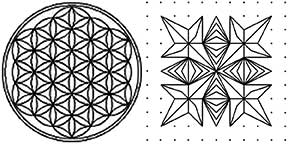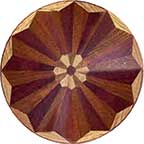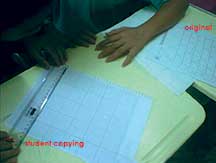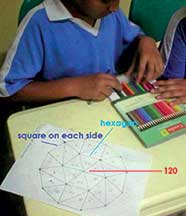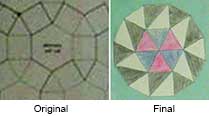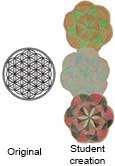Monica Kochar
How does one get students to enjoy the topic of construction of shapes? An important skill that is required is precision in drawing and that needs practice! Geometrical shapes as a topic needs repeated revision. The properties are easy to forget. So how about a project that reinforces construction of shapes in a way that students enjoy? A project that tests their skills in geometrical properties and construction of shapes can be fun!
A lot of students are afraid of math. These students can find a good outlet for their skills in a class where art is involved. Art work has a way of soothing emotions and I have found it an excellent medium to curb the fear of math. Time and again I have found students begin to like math because of the art projects I give them. I am giving below one project in detail combining geometry and art and a few ideas that teachers can follow on their own.
This project fulfills the requirement under CCE of comprehensive evaluation. It checks multiple facets of math – knowledge of shapes, skills of using geometrical properties and construction of shapes. It is also time bound and hence focuses on time management. Since this is a group project, it helps inculcate cooperative learning.
Steps
Teacher preparation
- This can be a group or an individual project. The teacher can decide which it should be. This should preferably be a team project of either two or three children so that students can combine their skills in math and art.
- The teacher will have to look up some good geometrical designs. Choose designs with a good geometrical base, designs that need construction of at least three different shapes.
For example, the design on the left is beautiful, but it involves only circles. It is complicated and it is of no use for a class trying to revise as many shapes as possible! The one on the right is better for it involves different shapes. It can also be approached in different ways by different students.
a. A good source for the designs is the book Sacred Geometry Design Sourcebook by Bruce Rawles. ISBN code 0-9656405-8-2. This is available online.
b. The other source is of course the Internet. Type in the search engine ’Geometrical designs’ or ‘geometrical rangoli designs’ and you will get plenty of designs.
Get prints of the designs, in black and white, so students can choose their colours to paint them later. The idea is for students to touch their own creativity. This helps students overcome their fear of math since it turns into a class where ‘creativity is possible’.
Student work
- Choose the shape
Let the students choose the shape according to what appeals to them. The aspect of choice is something teenagers love and this is a small way to bring it in. - Identify the shapes involved
The student has to first observe the shapes involved in the figure. This recaps the knowledge of shapes covered in the class. For example, in the following design I can notice a circle, kite, triangle, hexagon, and trapezium. - Figure out the geometry behind the creation
The student has to figure out how the design is created.
For example, in the following picture, you can see that the student chose a design. He observed it for a while and understood that to recreate it he needs to start with a lot of squares. Initially, he hurried. He made several attempts to get the quarter circles accurate and then realized that unless the squares are perfect he cannot create the design. Then he relaxed and went slow to get the “perfectly constructed figure”. - Recreate the design using construction tools – ruler, compass, protractor and pencil
Any geometrical design is created using geometrical properties. Trying to understand that makes the student recap the properties of geometrical shapes. Look at the constructed shape below:The students had to first make a circle, then an inclusive hexagon and then squares on each side of the hexagon. There are several ways to make a hexagon in a circle. The students chose to use the fact that total angles of a hexagon add to 720 and hence each central angle is 720/6 = 120.
- Convert it to a creative piece
Everyone loves to be creative. If creativity can be introduced in a math class, interest in math develops and increases.
The design used in step 4 and its final form was:You can observe the perfection of the construction. The students have used a simple colouring scheme, but note how neat the shading is. It is not out of the shape, nor is it messy.
Another pair of girls chose a design that I later realized was not appropriate, for it used only circles, but look at the perfection of their drawing! They took a lot of time till the circular design was perfect. Then they decided to create the final piece on their own.
- Present to class with explanation
When students present their work to the class, they have to clearly explain how they constructed the shape given. They have to give the geometrical basis of the shape.
The students who created the design had to explain how they constructed the hexagon and then the squares. They had to also explain why they chose one method over the other! They had to use the board to redraw the shape to illustrate.
Another student had to explain how he constructed a 20 sided polygon so perfectly. How is it that we know it is perfect…the diagonals all meet at one point in the centre!
The girls had to explain how their circles were so perfectly connected. They also explained why they created the final piece the way they did.
Assessment
We are always assessing. Judgment comes naturally to us. When we are assessing, there is always a criteria that we follow. For example, look at the work below. How much would you give out of 10?
Once you have decided your grade, think why you gave what you did and you will see that you do have a criterion of assessment!
The assessment too has to be as comprehensive as the project is. Since this is an inter-disciplinary project where there is math and art, group work within a specified time is essential. Therefore, there are three aspects of the project that make it comprehensive:
1. Math skills
a. Knowledge of shapes – did the student use all the shapes clearly?
b. Perfection of construction – how perfect is the design?
2. Art work
a. Creativity – is it created simply or is there some originality?
b. Overall presentation – is it neat and presentable or shoddy?
3. Personality
a. Time management – was the work on time or did it come after many reminders?
b. Group work – did the group work well together or were there many fights or complaints?
Hence assessment will also cover all of the above. Maximum marks will go to the most important criteria, that is, construction of shapes. Rest, the teacher can decide as per her choice.
My moment of joy!
This is my best moment in any class! This is what happened in this project:
These two students (whose work I have discussed here) were not that great in math. They never scored much and watched the other students score more than them. To their surprise, they found their art work perfect. Haltingly they spoke about their work, got applause from the class, got great score from me and … for the first time they smiled and were happy in the math class. They had achieved something! Their attitude was different from then on.
I think if we could change the attitude of students towards the subject of math from ‘fear to fun’, we are doing a great service to the next generation! And since art helps in so many ways to do that, why not try out something?
More ideas
There are other ways an art based work can be done in the class
- Ask the students to use all geometrical shapes they have studied so far. Create a design using them. All the shapes should be used and also they should be constructed perfectly.
a. You can add to idea 1 by also asking them to bring in ½ lines of symmetry to the design.
b. Ask them to also explain what the design is in their own words. This brings in the discipline of English also. - “Tile designs” are a great example of art and geometry. Ask students to create a design for a tile using geometry shapes.
- “Art and math corner” can be a permanent fixture for the classroom of the daring teacher! I did that in one of my sessions. Once a month everyone worked on art pieces. Those were the quietest classes ever!
The author has been a teacher for 19 years and is on a sabbatical from ‘schooling’. She is now a freelance math curriculum developer and is experimenting with strategies to make math accessible to all. She can be reached at reachmonica@gmail.com and has a blog titled http://humanemaths.blogspot.in.

